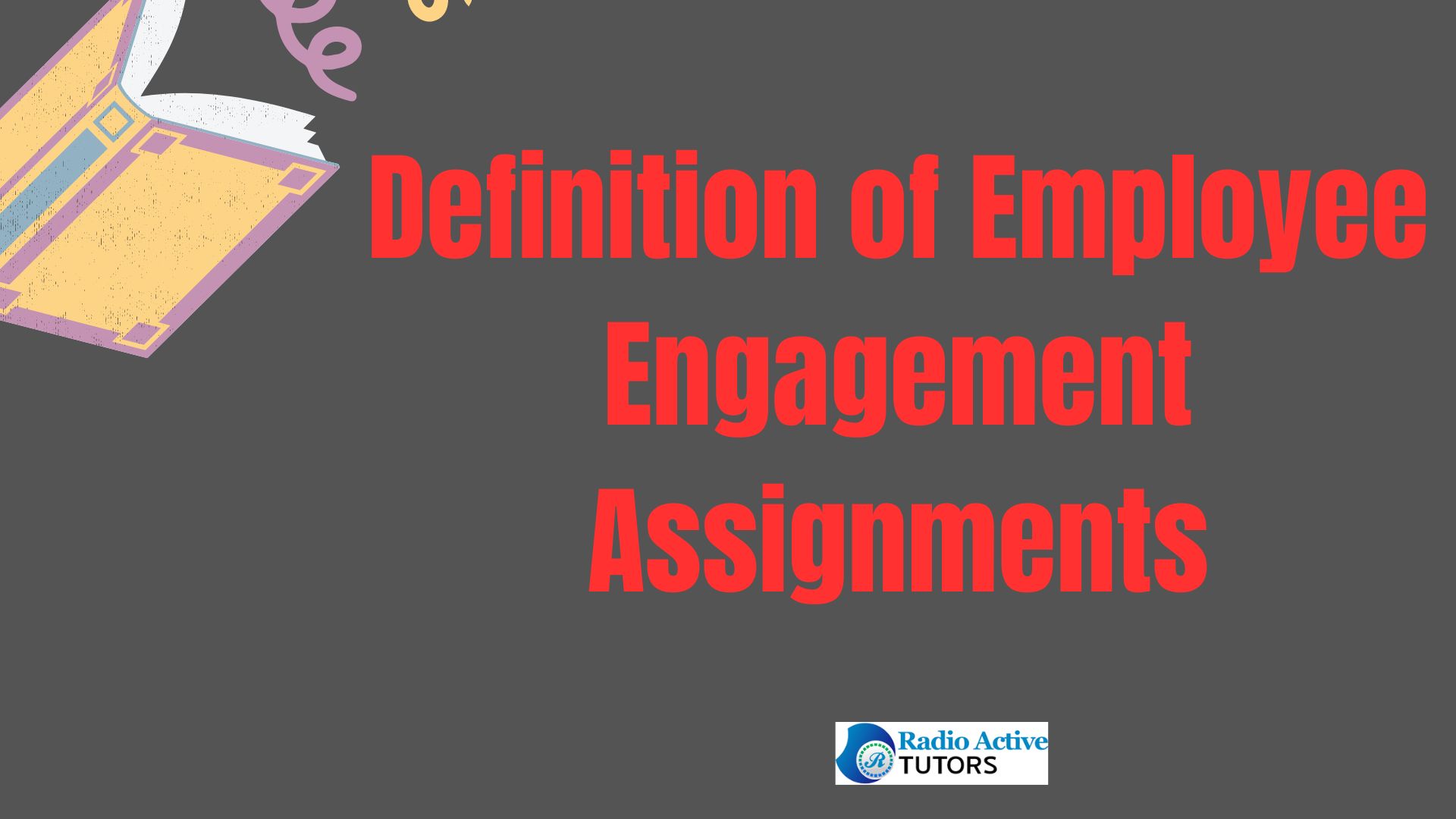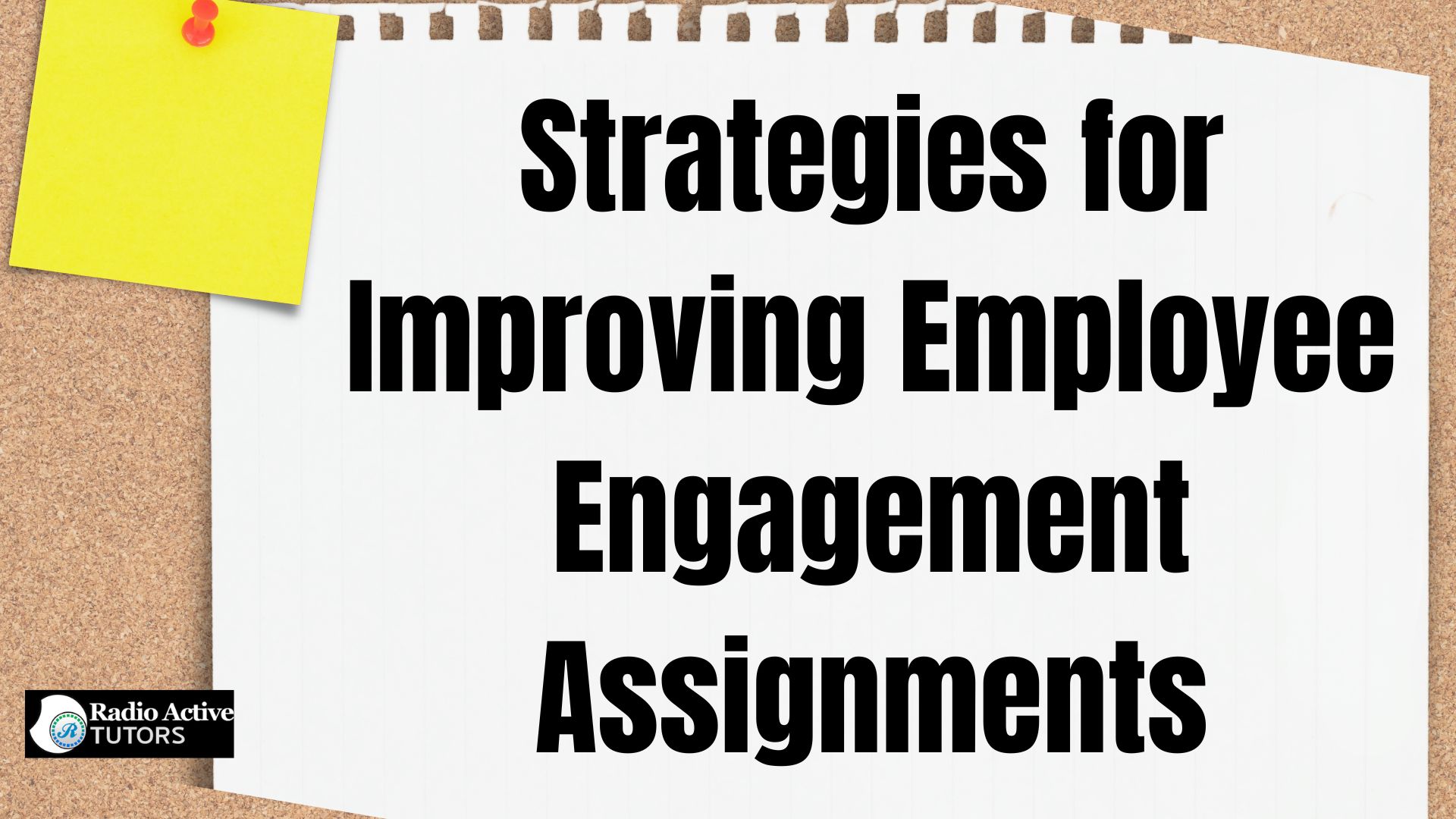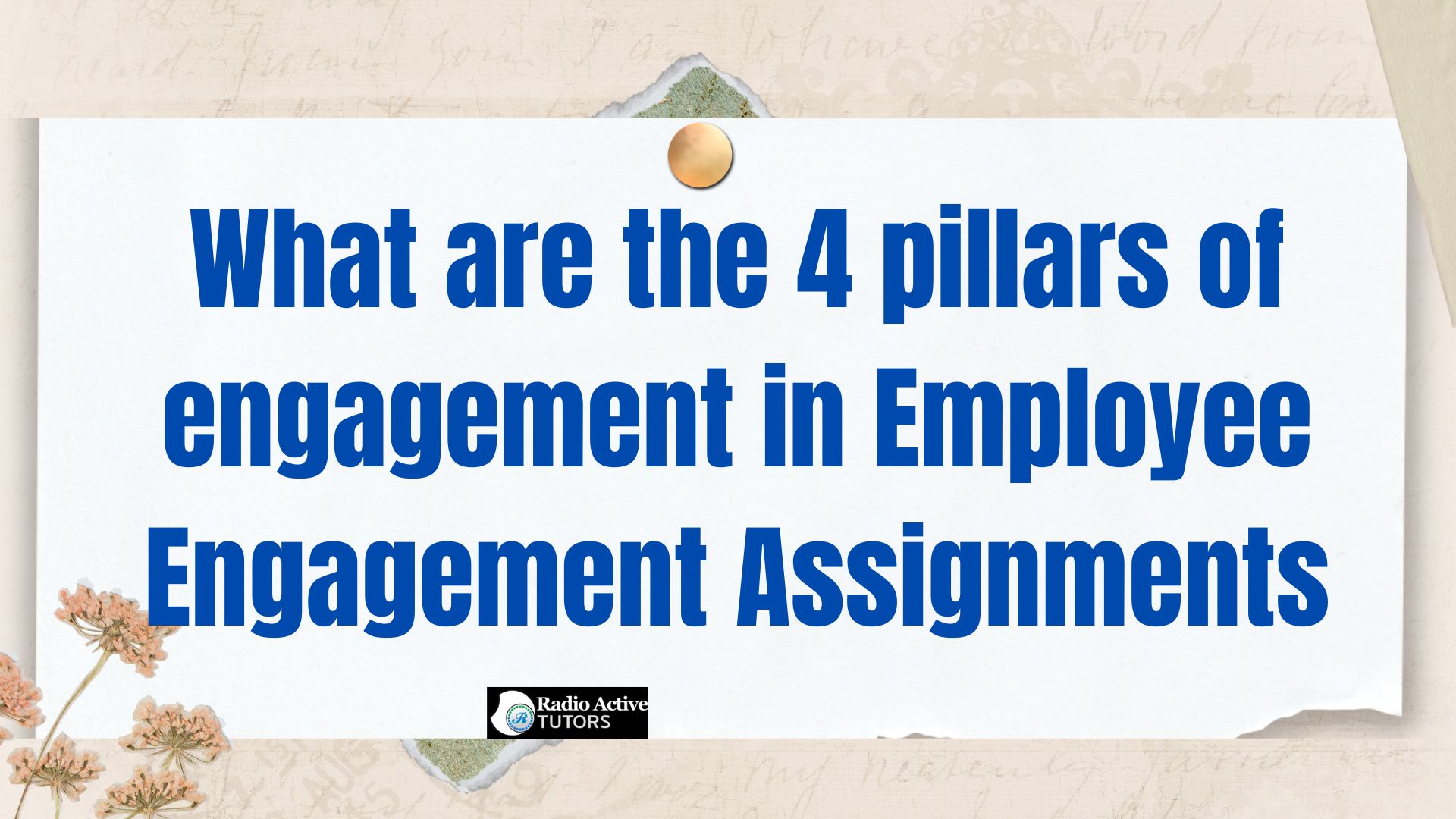Table of Contents
I. Introduction
II. Understanding Employee Engagement
III. What are the 5 C’s of employee engagement?
IV. Strategies for Improving Employee Engagement Assignments
V. Case Studies of Successful Employee Engagement Strategies
VI. Which are the five employee engagement components?
VII. Measuring the Success of Employee Engagement Assignments
VIII. What five management activities build employee engagement?
IX. What are the 4 pillars of engagement in Employee Engagement Assignments
X. Frequently Asked Questions (FAQs)
I. Introduction
A. Definition of Employee Engagement Assignments

Employee engagement assignments refer to specific tasks, projects, or initiatives designed by organizations to actively involve and motivate their employees. These assignments are strategically crafted to enhance employee satisfaction, productivity, and overall performance within the workplace. They serve as essential components of strategies aimed at improving employee engagement by providing opportunities for skill development, fostering a sense of ownership and purpose, and promoting collaboration and teamwork.
Employee engagement assignments can encompass a wide range of activities, including but not limited to goal-setting exercises, cross-functional projects, leadership development programs, and feedback mechanisms. By defining clear objectives and aligning assignments with the organization’s goals and values, employers can effectively cultivate a work environment where employees feel valued, empowered, and motivated to contribute their best efforts.
II. Understanding Employee Engagement Assignments
A. Factors Affecting Employee Engagement Assignments
In strategies for improving employee engagement assignments, it’s crucial to understand the factors that can impact employee engagement. Several factors influence the level of engagement employees feel towards their work, including organizational culture, leadership style, job design, and work environment. A positive and inclusive organizational culture that values transparency, trust, and collaboration fosters higher levels of engagement among employees. Effective leadership that provides clear direction, support, and recognition encourages employees to feel valued and motivated.
Additionally, well-designed job roles that offer opportunities for growth, challenge, and autonomy contribute to increased engagement. Moreover, a supportive work environment that promotes work-life balance and provides resources for employee well-being also plays a significant role. By addressing these factors and implementing strategies to improve them within employee engagement assignments, organizations can create an environment where employees feel motivated, committed, and fulfilled in their roles.
III. What are the 5 C’s of employee engagement Assignments?
The 5 C’s of employee engagement Assignments represent crucial elements that organizations focus on to enhance their employees’ involvement and commitment. These include:
- Connection: Building a strong connection between employees and the organization by fostering open communication, providing opportunities for meaningful interactions, and promoting a sense of belonging and community.
- Commitment: Encouraging employees to be dedicated and invested in their work by aligning their individual goals with the organization’s mission and values, recognizing their contributions, and offering opportunities for growth and advancement.
- Contribution: Empowering employees to make meaningful contributions to the organization’s success by involving them in decision-making processes, delegating responsibilities that leverage their skills and expertise, and acknowledging their achievements and impact.
- Culture: Creating a positive and inclusive work culture that values diversity, promotes transparency and trust, encourages innovation and creativity, and fosters a supportive and collaborative environment where employees feel valued and respected.
- Career: Providing opportunities for career development and growth by offering training and development programs, mentoring and coaching initiatives, career advancement opportunities, and clear pathways for progression within the organization. By focusing on these 5 C’s in strategies for improving employee engagement assignments, organizations can effectively nurture a culture of engagement, motivation, and satisfaction among their workforce.
IV. Strategies for Improving Employee Engagement Assignments

A. Clear Goal Setting
Clear goal setting is a foundational element in strategies aimed at improving employee engagement assignments. By establishing clear and specific goals, organizations provide employees with a roadmap for success and a sense of direction in their work. Clear goals help employees understand what is expected of them, prioritize their tasks, and stay focused on achieving measurable outcomes.
Moreover, when employees have a clear understanding of their goals, they are more motivated and committed to their assignments, as they can see the purpose and significance behind their work. Clear goal setting also facilitates effective communication between managers and employees, ensuring alignment of expectations and providing opportunities for feedback and support along the way. Overall, clear goal setting is essential for creating a supportive and engaging work environment where employees feel empowered to excel and contribute to the organization’s success.
1. SMART Objectives in Employee Engagement Assignments
In the realm of strategies for improving employee engagement assignments, employing SMART objectives is essential for clear goal setting and effective execution. SMART stands for Specific, Measurable, Achievable, Relevant, and Time-bound, providing a structured framework for goal setting that ensures objectives are well-defined and attainable. By setting specific goals, organizations can provide clarity and direction, outlining precisely what needs to be achieved.
Making objectives measurable enables progress tracking and evaluation, allowing for adjustments as needed. Ensuring goals are achievable promotes motivation and confidence among employees, preventing overwhelm or frustration. Aligning objectives with the broader organizational objectives ensures relevance and significance, while setting time-bound targets establishes deadlines and accountability, driving focus and momentum. Incorporating SMART objectives into clear goal setting for employee engagement assignments enhances clarity, accountability, and ultimately, the success of initiatives aimed at fostering employee engagement.
2. Aligning Assignments with Organizational Goals in Employee Engagement Assignments
Aligning assignments with organizational goals is a critical aspect of clear goal setting in strategies for improving employee engagement assignments. When assignments are closely aligned with the broader objectives and mission of the organization, employees gain a clear understanding of how their work contributes to the overall success of the company. This alignment fosters a sense of purpose and meaning in their tasks, motivating them to perform at their best.
By ensuring that assignments are directly linked to organizational goals, businesses can increase employee engagement by providing employees with a sense of direction, focus, and relevance in their work. Additionally, this alignment facilitates better communication and coordination across teams, as everyone is working towards common objectives. Ultimately, by aligning assignments with organizational goals, companies can drive employee engagement and achieve greater success in their endeavors.
B. Providing Autonomy
Providing autonomy is a pivotal strategy in improving employee engagement assignments. When employees are granted autonomy, they are given the freedom and flexibility to make decisions, solve problems, and execute tasks in a manner that aligns with their skills, preferences, and expertise. This sense of independence empowers employees, instilling a feeling of ownership and accountability for their work.
By allowing individuals to take control of their assignments, organizations foster a culture of trust and respect, where employees feel valued and empowered to contribute their best efforts. Providing autonomy also encourages creativity and innovation, as employees are encouraged to explore new ideas and approaches without fear of micromanagement. Overall, by incorporating autonomy into strategies for improving employee engagement assignments, organizations can cultivate a more motivated, satisfied, and productive workforce.
1. Empowering Employees in enhancing employee engagement assignments
Empowering employees by providing autonomy is a key strategy for improving employee engagement assignments. When employees are given the freedom to make decisions, exercise creativity, and take ownership of their work, they feel a greater sense of responsibility and control over their tasks. This autonomy not only enhances their job satisfaction but also fosters a deeper level of commitment and investment in their assignments.
Empowered employees are more likely to demonstrate initiative, innovation, and problem-solving skills, leading to higher levels of productivity and performance. By entrusting employees with autonomy in their assignments, organizations demonstrate trust and confidence in their abilities, which in turn motivates employees to excel and contribute positively to the organization’s success. Overall, providing autonomy is a powerful strategy for improving employee engagement assignments as it empowers employees to take charge of their work and become more invested in achieving shared goals.
2. Encouraging Decision-Making in improving Employee Engagement Assignments
Encouraging decision-making by providing autonomy is a vital component of strategies aimed at improving employee engagement assignments. When employees are empowered to make decisions regarding their work, they feel a greater sense of ownership and responsibility. This empowerment not only boosts their confidence but also fosters a culture of trust and collaboration within the organization.
Encouraging decision-making allows employees to leverage their unique skills and expertise to solve problems and innovate, leading to more effective and efficient outcomes. Moreover, it promotes a sense of accountability as employees understand the impact of their decisions on the overall success of their assignments. By fostering an environment where decision-making is encouraged and supported, organizations can enhance employee engagement, job satisfaction, and ultimately, performance.
C. Offering Development Opportunities

Offering development opportunities is a fundamental strategy in enhancing employee engagement assignments. By providing employees with opportunities for growth, learning, and advancement, organizations demonstrate a commitment to investing in their professional development and success. Development opportunities can take various forms, including training programs, mentorship initiatives, workshops, and skill-building activities.
These opportunities not only enable employees to enhance their skills and knowledge but also empower them to take on new challenges and responsibilities within their assignments. Moreover, offering development opportunities fosters a culture of continuous learning and improvement, where employees are encouraged to expand their capabilities and reach their full potential. By prioritizing development opportunities within employee engagement assignments, organizations can inspire motivation, loyalty, and engagement among their workforce, leading to greater job satisfaction and overall success.
1. Training and Skill Enhancement in Employee Engagement Assignments
Training and skill enhancement play a crucial role in offering development opportunities within strategies for improving employee engagement assignments. By investing in training programs and initiatives aimed at enhancing employees’ skills and capabilities, organizations not only empower their workforce but also demonstrate a commitment to their professional growth and advancement. Providing employees with opportunities to learn new skills, acquire knowledge, and develop expertise not only enhances their job performance but also boosts their confidence and motivation.
Additionally, training and skill enhancement initiatives enable employees to tackle new challenges, adapt to changing work environments, and contribute more effectively to the organization’s success. By prioritizing training and skill development within employee engagement assignments, organizations can foster a culture of continuous learning, growth, and improvement, thereby enhancing overall employee engagement and satisfaction.
2. Stretch Assignments in Employee Engagement Assignments
Stretch assignments are a valuable component of offering development opportunities within strategies for improving employee engagement assignments. These assignments involve tasks or projects that challenge employees to step outside their comfort zones, take on new responsibilities, and develop new skills. By providing stretch assignments, organizations not only offer employees opportunities for growth and development but also demonstrate trust in their abilities to handle challenging tasks. These assignments encourage employees to push their boundaries, expand their capabilities, and foster a sense of accomplishment and pride in their work.
Additionally, stretch assignments can enhance employee engagement by promoting a sense of excitement and motivation as employees tackle new and unfamiliar tasks. By incorporating stretch assignments into employee engagement strategies, organizations can foster a culture of continuous learning, development, and innovation, ultimately leading to increased employee satisfaction , reduced workplace employee conflict and organizational success.
D. Regular Feedback and Communication in Employee Engagement Assignments
Regular feedback and communication are integral components of strategies aimed at improving employee engagement assignments. Maintaining open lines of communication allows for ongoing dialogue between employees and managers, fostering a collaborative and supportive work environment. Through regular feedback sessions, employees receive valuable insights into their performance, strengths, and areas for improvement, enabling them to make necessary adjustments and grow professionally.
Additionally, consistent communication ensures that employees feel heard, valued, and connected to the organization, enhancing their sense of belonging and commitment. By prioritizing regular feedback and communication within employee engagement assignments, organizations can promote transparency, trust, and accountability, ultimately leading to higher levels of employee satisfaction and engagement.
1. Open-door Policy in Employee Engagement Assignments
An open-door policy is a fundamental aspect of regular feedback and communication within strategies for improving employee engagement assignments. This policy encourages transparency, accessibility, and trust between employees and management, fostering an environment where employees feel comfortable expressing their ideas, concerns, and feedback. By maintaining an open-door policy, organizations demonstrate a commitment to listening to their employees’ perspectives and valuing their input.
This open communication channel enables employees to seek clarification, provide suggestions, and address any issues or challenges they may encounter in their assignments. Moreover, it promotes a culture of collaboration and collaboration, as employees feel empowered to contribute their ideas and insights to improve processes and outcomes. By prioritizing open communication through an open-door policy, organizations can enhance employee engagement, morale, and overall satisfaction, leading to a more productive and successful work environment.
2. Constructive Feedback Mechanisms in Employee Engagement Assignments
Constructive feedback mechanisms are essential components of regular feedback and communication within strategies for improving employee engagement assignments. These mechanisms provide employees with valuable insights into their performance, strengths, and areas for improvement, enabling them to grow and develop professionally. By offering constructive feedback, managers and colleagues can help employees understand their progress, identify any challenges they may face, and offer guidance on how to overcome them.
Constructive feedback also fosters a culture of continuous learning and improvement, as employees are encouraged to reflect on their work and make adjustments to enhance their skills and effectiveness. Additionally, receiving constructive feedback demonstrates that the organization values employee development and is invested in their success. By incorporating constructive feedback mechanisms into regular communication channels, organizations can promote a culture of transparency, accountability, and growth, ultimately leading to higher levels of employee engagement and satisfaction.
V. Case Studies of Successful Employee Engagement Strategies in Employee Engagement Assignments
Case studies of successful employee engagement strategies serve as invaluable learning tools within strategies for improving employee engagement assignments. By examining real-world examples of organizations that have effectively boosted employee engagement, businesses can glean insights, identify best practices, and tailor their own approaches accordingly.
These case studies showcase various strategies and initiatives implemented by successful companies, such as fostering a culture of recognition, providing opportunities for skill development, promoting work-life balance, and fostering open communication channels. Through detailed analysis of these case studies, organizations can gain a deeper understanding of the factors that contribute to employee engagement and apply these insights to enhance their own engagement assignments. By leveraging the lessons learned from successful case studies, businesses can develop more targeted and effective strategies for improving employee engagement, leading to a more motivated, satisfied, and productive workforce.
VI. Which are the five employee engagement components in Employee Engagement Assignments?

In strategies for improving employee engagement assignments, there are five key components that play a crucial role in fostering a culture of engagement and motivation within an organization. These components include:
- Clear Expectations: Providing employees with clear and transparent expectations regarding their roles, responsibilities, and performance objectives ensures alignment with organizational goals and fosters a sense of purpose and direction.
- Meaningful Work: Leadership assignments ensures that employess are assigned tasks and projects that are challenging, stimulating, and meaningful to employees’ interests and career aspirations helps cultivate a sense of fulfillment and satisfaction in their work.
- Recognition and Rewards: Acknowledging and rewarding employees for their contributions, achievements, and efforts reinforces positive behaviors, boosts morale, and encourages continued engagement and performance excellence.
- Opportunities for Growth: Offering opportunities for professional development, skill enhancement, and career advancement through training programs, mentorship initiatives, and promotion pathways demonstrates a commitment to employees’ long-term success and fosters loyalty and commitment.
- Feedback and Communication: Establishing open and honest channels of communication for regular feedback, constructive criticism, and dialogue between employees and managers promotes transparency, trust, and collaboration, ultimately enhancing engagement and performance levels. By incorporating these five employee engagement components into strategies for improving employee engagement assignments, organizations can create a supportive and motivating work environment that empowers employees to thrive and contribute their best efforts.
VII. Measuring the Success of Employee Engagement Assignments
Measuring the success of employee engagement assignments is integral to strategies aimed at enhancing overall employee engagement within an organization. Effective measurement allows businesses to assess the impact and effectiveness of their initiatives, identify areas for improvement, and make informed decisions moving forward.
Key metrics for measuring success may include employee satisfaction and morale levels, productivity and performance indicators, retention rates, and feedback from employees regarding their experiences with the assignments. Additionally, tracking qualitative data such as employee feedback, testimonials, and anecdotal evidence can provide valuable insights into the perceived value and impact of the assignments. By analyzing these metrics and feedback, organizations can gauge the effectiveness of their employee engagement assignments, refine their strategies, and continuously strive to create a more engaging and fulfilling work environment for their employees.
VIII. What five management activities build employee engagement assignments ?
In strategies for improving employee engagement assignments, there are five key management activities that are instrumental in building employee engagement. Firstly, effective communication is essential; managers should regularly communicate organizational goals, expectations, and feedback to ensure clarity and alignment. Secondly, providing recognition and rewards for employees’ contributions and achievements boosts morale and motivates continued engagement. Thirdly, offering opportunities for growth and development through training, mentorship, and career advancement programs demonstrates a commitment to employees’ professional success.
Fourthly, fostering a positive work environment that promotes teamwork, collaboration, and inclusivity creates a sense of belonging and satisfaction among employees. Finally, empowering employees by delegating responsibilities, granting autonomy, and involving them in decision-making processes cultivates a sense of ownership and investment in their work. By focusing on these five management activities, organizations can effectively improve employee engagement assignments and create a more engaged and productive workforce.
IX. What are the 4 pillars of engagement in Employee Engagement Assignments

In strategies for improving employee engagement assignments, there are four fundamental pillars that serve as the cornerstone for fostering and maintaining high levels of engagement among employees. These pillars include:
- Purpose: Providing employees with a clear sense of purpose and alignment with the organization’s mission, vision, and values. Assignments should be meaningful and contribute to overarching goals, allowing employees to understand how their work impacts the broader objectives of the company.
- Autonomy: Empowering employees with a degree of autonomy and control over their work enables them to make decisions, exercise creativity, and take ownership of their assignments. This autonomy fosters a sense of responsibility and accountability, leading to increased engagement and job satisfaction.
- Mastery: Offering opportunities for skill development, growth, and mastery within assignments allows employees to continuously improve and excel in their roles. Providing training, resources, and feedback facilitates personal and professional development, leading to greater job satisfaction and engagement.
- Connection: Cultivating a sense of connection and belonging among employees through effective communication, collaboration, and teamwork is essential. Encouraging relationships, fostering a supportive work environment, and promoting inclusivity and camaraderie enhance engagement and create a sense of community within the organization. By focusing on these four pillars of engagement in employee engagement assignments, organizations can create a conducive environment that motivates and inspires employees to perform at their best.
X. Frequently Asked Questions (FAQs)
A. What is the difference between Employee Engagement Assignments and employee satisfaction assignments ?
B. How can I measure the effectiveness of my employee engagement assignments?
C. What role does communication play in employee engagement assignments ?
D. How do I address resistance to change when implementing new engagement strategies for Employee Engagement Assignments?
E. Can employee engagement assignments improve retention rates?
